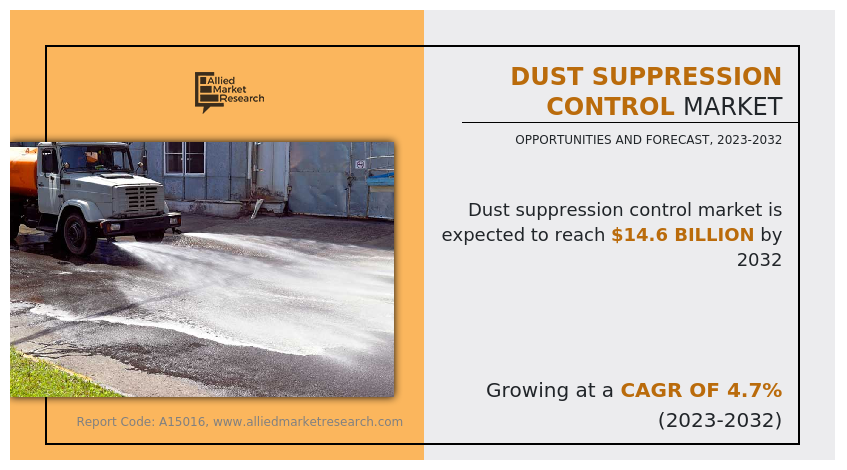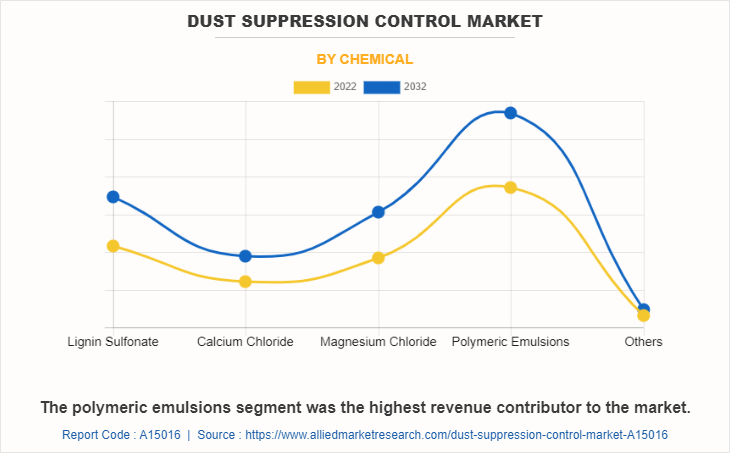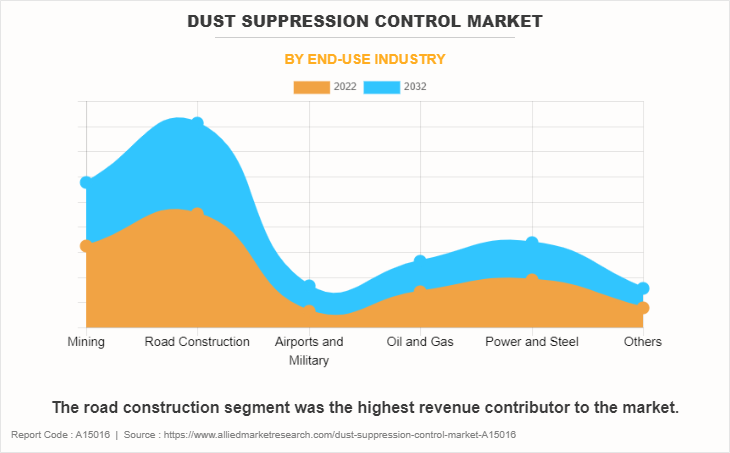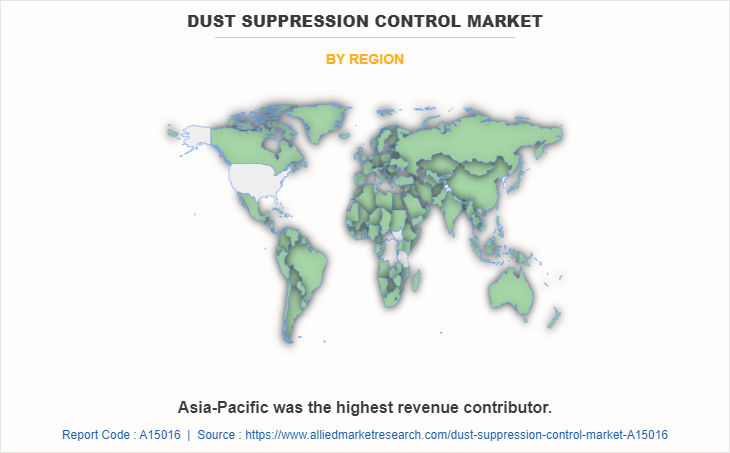Dust Suppression Control Market Research, 2032
The global dust suppression control market was valued at $9.2 billion in 2022, and is projected to reach $14.6 billion by 2032, growing at a CAGR of 4.7% from 2023 to 2032.
Key Report Highlighters:
- The report depicts detailed insights on the dust suppression control industry trends and new growth opportunities.
- The report provides complete analysis on the market status across key regions and more than 15 countries across the globe in terms of value ($ Million) and volume (Kilotons).
- The report identifies the dust suppression control market growth segments and emerging application areas.
- The report provides competitive dynamics by evaluating business segments, product portfolios, target market revenue, geographical presence and key strategic developments by prominent manufacturers.
- The report facilitates strategy planning and industry dynamics to enhance decision making for existing market players and new entrants entering dust suppression control industry.

Dust suppression agents are chemicals that are developed to contain ground surface particles together, thereby preventing the creation of dust. It is sometimes blended with water for dilution. Dust suppression chemicals are an effective way of controlling air pollution at the source of its creation. For instance, in a coal mine, a lot of coal dust is created due to the drilling and excavation process. Further, dust is generated during the transportation of coal from the mine to the next point. If left uncontrolled, it leads to many health and safety hazards for employees and residents. In such areas, dust control agents work as effective binding agents that form a surface film coating when used in higher concentrations.
Dust suppressants are used to reduce fugitive dust particles created in mining and construction environments. Environments could be coal exploration mines or roads that are used to transport coal. In such areas, the need for site visibility is of utmost priority. In addition, the health of mine workers and people living in the vicinity of the quarry is also important. Coal dust has a lot of health issues upon long exposure. Hence, governments tend to tighten rules around the permissible value of dust particles near coal mines. Therefore, mitigating dust particles at the source of their generation is expected to increase demand for dust suppression control products during the forecast period.
However, a lack of product awareness among various end-use industry participants tends to hamper the growth of the global dust suppression control market. In Asian countries such as India, the concept of using a dust control agent to mitigate dust is still dim. Spraying water on road surfaces is still a common dust-controlling method. Moreover, there are mechanical dust collectors that do not use any chemicals to remove dust particles. Such alternatives tend to limit the growth of the global dust suppression control market.
On the contrary, rise in awareness for effective dust control measures increases the prospects of chemical-based dust binding agents. Chemical-based dust suppressants bond to the surface upon evaporation of water. As compared to plain water, this bond lasts longer, thereby saving application time and resources. All such factors are expected to offer lucrative opportunities for the growth of the global dust suppression control market during the forecast period.
“Clearing the Air: The Future of Dust Suppression Control”
Increase in awareness of air pollution and growing global warming have led to increase in investments toward the improvement of the living space, which increase the demand for dust suppression control. The rise in the population across the globe has led to the rapid development in industrialization and urbanization, thus increasing the dust particles in the atmosphere, which are harmful for the people.
The increase in health issues related to dust has led to rise in demand for dust suppression control measures, which positively impacts the market. In addition, stringent regulations and policies from the government on the major dust-producing industries such as mining and chemical manufacturing industries, significantly impact the market development.
The dust suppression control market is segmented on the basis of chemical, end-use industry, and region. On the basis of chemical, the dust suppression control market is segmented into lignin sulfonate, calcium chloride, magnesium chloride, polymeric emulsions, and others. By end-use industry, it is divided into mining, road construction, airports & military, oil & gas, power & steel, and others. Region-wise, it is segmented into North America, Europe, Asia-Pacific, and LAMEA.

Polymeric emulsions dominated the global dust suppression control market share. It is widely used in diverse industries which includes construction, mining, roadways, agriculture, and others, due to its versatile and highly effective nature. It offers superior efficiency to bind dust particles, and prevent them from airborne. Moreover, their long-lasting effects and environmentally friendly properties make them a preferred choice for sustainability-conscious industries.

Road construction segement dominated maximum dust suppression control market size of industry share, due to increase in the investment toward the transportation infrastructure related activities in the developing countries across the globe. The presence of targets, policies and plans from the developing countries such as India, Brazil, and others have boosted the demand for dust suppression control measures and products which lead to the market growth.

Asia-Pacific region dominated the global dust suppression control market industry, due to presence of developing countries and presence of highly populated countries in this region such as India and China has led to the development in the construction of various industries and infrastructure investment. The above mentioned factors will drive the demand for the dust suppression control measures which inturns boost the market growth during the forecast period.
Key players engaged in the development and production of dust suppression control products are Benetech, Inc., Borregaard, Cargill Inc., COLAS Group, Ecolab Inc., Global Road Technology International Holdings, Reynolds Soil Technologies Pty Ltd., Solvay SA, Suez, Tetra Technologies, DBD Global, BMA Ambiental, Solenis, and SNF. The companies' unique services and innovative approaches contribute to the advancement of the dust suppression control market, enabling more efficient, sustainable, and environmentally friendly practices for corporates to move toward sustainability.
Key Benefits For Stakeholders
- This report provides a quantitative analysis of the market segments, current trends, estimations, and dynamics of the dust suppression control market analysis from 2022 to 2032 to identify the prevailing dust suppression control market opportunities.
- The market research is offered along with information related to key drivers, restraints, and opportunities.
- Porter's five forces analysis highlights the potency of buyers and suppliers to enable stakeholders make profit-oriented business decisions and strengthen their supplier-buyer network.
- In-depth analysis of the dust suppression control market segmentation assists to determine the dust suppression control market forecast.
- Major countries in each region are mapped according to their revenue contribution to the global market.
- Market player positioning facilitates benchmarking and provides a clear understanding of the present position of the market players.
- The report includes the analysis of the regional as well as global dust suppression control market trends, key players, market segments, application areas, and market growth strategies.
Dust Suppression Control Market Report Highlights
| Aspects | Details |
| Market Size By 2032 | USD 14.6 billion |
| Growth Rate | CAGR of 4.7% |
| Forecast period | 2022 - 2032 |
| Report Pages | 309 |
| By Chemical |
|
| By End-Use Industry |
|
| By Region |
|
| Key Market Players | Colas Group, Global Road Technology International Holdings (HK) Limited, Benetech, Inc., BMA Ambiental, SNF, Suez, Cargill, Incorporated, Ecolab Inc., Solvay, TETRA Technologies, Inc., Reynolds Soil Technologies Pty Ltd., Borregaard ASA, Solenis, Den Bakker Dustcrusting Technology B.V. |
Analyst Review
CXOs in the dust suppression control market perceive a landscape of immense growth potential, fueled by various drivers such as the continuous expansion of environmental regulations and concerns surrounding conventional electrical wiring systems. CXOs also said that there is a surging demand for dust suppression control solutions that offer heightened safety, enduring durability, and unwavering sustainability.
CXOs firmly believe that the market prospects for dust suppression control will continue to witness remarkable growth in the forthcoming years. They recognize the importance of infusing their products with advanced and progressive elements to meet the ever-evolving needs of customers. Embracing transformative technologies, such as AI, IoT, and robotics, CXOs envision enhancing the performance and effectiveness of dust suppression control systems. Through such innovation, they aspire to provide their clients with groundbreaking solutions that optimize the control over dust in the manufacturing facilities, yielding sustainable outcomes.
Customers, stakeholders, and regulators all share a collective appreciation for eco-conscious solutions, a corporate social responsibility , which CXOs wholeheartedly acknowledge. Consequently, CXOs strive to fortify and promote products and manufacturing procedures that minimize environmental impact.
The presence of corporate social responsibility that involves utilizing recyclable materials, curbing emission of dust particles during production, and advocate for energy-efficient installations has significant impact on the market. CXOs seek to attract environmentally friendly customers while bolstering their corporate reputation by optimizing their operations with sustainable goals. CXOs lay significant emphasis to maintain a cutting-edge stance through technological advancements in the industry through expansion and innovation.
Thriving on information analytics, automation, and remote monitoring, CXOs leverage these transformative technologies to optimize manufacturing processes, elevate operational efficiency, and ensure unwavering regulatory compliance. These factors lead to technological progress which empowers CXOs to offer cost-effective and efficient solutions to their clients, thereby propelling the industry forward through innovation.
The estimated industry size of Dust Suppression Control Market is around $14.6 Billion in 2032.
Increased focus on sustainability, integration of IoT and AI, and shift towards the dry suppression methods are the upcoming trends of Dust Suppression Control Market.
Road Construction is the leading application of Dust Suppression Control Market.
Asia-Pacific is the largest regional market for Dust Suppression Control Market.
Ecolab Inc., Solvay, SUEZ, SNF, and Cargill, Incorporated are the top companies to hold the market share in Dust Suppression Control Market.
Change in rules around safe dust levels in mining and quarry environments is the main driver of Dust Suppression Control Market.
Loading Table Of Content...
Loading Research Methodology...


